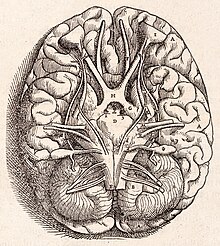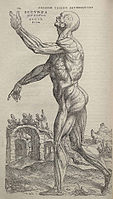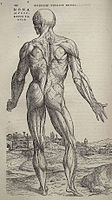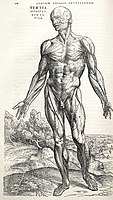Andreas Vesalius
Andreas Vesalius | |
|---|---|
 | |
| Born | 31 December 1514 |
| Died | 15 October 1564 (aged 49) |
| Known for | De humani corporis fabrica or "the structure of the human body" |
| Scientific career | |
| Fields | Anatomy |
| Doctoral advisor | Johannes Winter von Andernach Gemma Frisius |
| Doctoral students | Matteo Realdo Colombo |
Andreas Vesalius (31 December 1514 – 15 October 1564) was a Brabantian (in modern-day Belgium) anatomist, physician, and author of one of the most influential books on human anatomy, De humani corporis fabrica (On the Fabric of the Human Body). Vesalius is often referred to as the founder of modern human anatomy. He was professor at the University of Padua and later became Imperial physician at the court of Emperor Charles V.
Andreas Vesalius is the Latinized form of the Dutch Andries van Wesel, a common practice among European scholars in his time. His name is also given as Andrea Vesalius, Andrea Vesalio, Andreas Vesal, André Vesalio and Andre Vesalepo.
Medical career
The day of his graduation he was immediately offered the chair of Surgery and Anatomy (explicator chirurgiae) at Padua. He also guest lectured at Bologna and Pisa. Previously these topics had been taught primarily from reading classical texts, mainly Galen, followed by an animal dissection by a barber-surgeon whose work was directed by the lecturer. No attempt was made to actually check Galen's claims; these were considered unassailable. Vesalius, on the other hand, carried out dissection as the primary teaching tool, handling the actual work himself and urging students to perform dissection themselves. Hands-on direct observation was considered the only reliable resource, a huge break with medieval practice.
He created detailed illustrations of anatomy for students in the form of six large woodcut anatomical posters. When he found that some of these were being widely copied, he published them all in 1538 under the title Tabulae anatomicae sex. He followed this in 1539 with an updated version of Guinter's anatomical handbook, Institutiones anatomicae.
In 1539 he also published his Venesection letter, on bloodletting. This was a popular treatment for almost any illness, but there was some debate about where to take the blood from. The classical Greek procedure, advocated by Galen, was to let blood from a site near the location of the illness. However, the Muslim and medieval practice was to draw a smaller amount blood from a distant location. Vesalius' pamphlet generally supported Galen's view, but with qualifications that rejected the infallibility of Galen.
In 1541, while in Bologna, Vesalius uncovered the fact that all of Galen's research had been based upon animal anatomy rather than the human; since dissection had been banned in ancient Rome, Galen had dissected Barbary apes instead, and argued that they would be anatomically similar to humans. He also contributed to the new Giunta edition of Galen's collected works and began writing his own anatomical text. Until Vesalius pointed out Galen's substitution of animal for human anatomy, it had gone unnoticed and had long been the basis of studying human anatomy. However, some people still chose to follow Galen and resented Vesalius for calling attention to such glaring mistakes.
Galen assumed arteries carried the purest blood to higher organs such as the brain and lungs from the left ventricle of the heart, while veins carried blood to the lesser organs such as the stomach from the right ventricle. In order that this theory could be correct some sort of holes were needed to interconnect the ventricles, and so in the spirit of Galen's time, he claimed to have found them, adjusting the facts to suit his theory. So paramount was the authority of Galen that for 1400 years a succession of anatomists had claimed to find these holes until finally Vesalius admitted he could not find them. However, while Vesalius dared to admit he could not find these holes, he did not dream of disputing Galen on the distribution of blood, and so imagined it distilled through the unbroken partition between the ventricles.[1]
Other famous examples of Vesalius disproving Galen in particular was his discovery that the lower jaw (mandible) was only one bone, not two (which Galen had assumed from animal dissection) and his proof that humans do not have the "miraculous network" of blood vessels at the base of the brain which is found in sheep and other ungulates.
In 1543, Vesalius conducted a public dissection of the body of Jakob Karrer von Gebweiler, a notorious felon from the city of Basel, Switzerland. He assembled the bones and finally donated the skeleton to the University of Basel. This preparation ("The Basel Skeleton") is Vesalius' only well-preserved skeletal preparation today, and is also the world's oldest surviving anatomical preparation. It is still displayed at the Anatomical Museum of the University of Basel.[2]
In the same year Vesalius took residence in Basel to help Johannes Oporinus publish the seven-volume De humani corporis fabrica (On the fabric of the human body), a groundbreaking work of human anatomy which he dedicated to Charles V. Many believe it was illustrated by Titian's pupil Jan Stephen van Calcar, but evidence is lacking, and it is unlikely a single artist created all 273 illustrations in so short a time. About the same time he published an abridged edition for students, Andrea Vesalii suorum de humani corporis fabrica librorum epitome, and dedicated it to Philip II of Spain, son of the Emperor.
Though Vesalius' work was not the first such work based on actual autopsy, nor even the first work of this era, the production values, highly detailed and intricate plates, and the likelihood that the artists who produced it were clearly present at the dissections themselves made it into an instant classic. Pirated editions were available almost immediately, a fact Vesalius acknowledged would happen in a printer's note. Vesalius was 28 years old when the first edition of Fabrica was published.
Imperial physician and death
Soon after publication, Vesalius was invited as Imperial physician to the court of Emperor Charles V. He informed the Venetian Senate that he was leaving his post in Padua, which prompted Duke Cosimo I de' Medici to invite him to move to the expanding university in Pisa, which he turned down. Vesalius took up a position in the court, where he had to deal with the other physicians mocking him as being a barber.
Over the next eleven years Vesalius traveled with the court, treating injuries from battle or tournaments, performing postmortems, administering medications, and writing private letters addressing specific medical questions. During these years he also wrote the Epistle on the China root, a short text on the properties of a medical plant whose efficacy he doubted, as well as defense of his anatomical findings. This elicited a new round of attacks on his work that called for him to be punished by the emperor. In 1551, Charles V commissioned an inquiry in Salamanca to investigate the religious implications of his methods. Vesalius' work was cleared by the board, but the attacks continued. Four years later one of his main detractors and one-time professors Jacobus Sylvius, published an article that claimed that the human body itself had changed since Galen had studied it.
After the abdication of Emperor Charles V he continued at court in great favor with his son Philip II, who rewarded him with a pension for life by making him a count palatine. In 1555 he published a revised edition of De humani corporis fabrica.
In 1564 Vesalius went on a pilgrimage to the Holy Land. He sailed with the Venetian fleet under James Malatesta via Cyprus. When he reached Jerusalem, he received a message from the Venetian senate requesting him again to accept the Paduan professorship, which had become vacant by the death of his friend and pupil Fallopius.
After struggling for many days with the adverse winds in the Ionian Sea, he was wrecked on the island of Zakynthos. Here he soon died in such debt that a benefactor kindly paid for his funeral. At the time of his death he was scarcely fifty years of age. He was buried somewhere in the island of Korfu.
For many years it was assumed that Vesalius's pilgrimage was due to pressures of the Inquisition. Today this is generally considered to be without foundation (see C.D. O'Malley Andreas Vesalius' Pilgrimage, Isis 45:2, 1954) and is dismissed by modern biographers. It appears the story was spread by Hubert Languet, a diplomat under Emperor Charles V and then under the Prince of Orange, who claimed in 1565 that Vesalius had performed an autopsy on an aristocrat in Spain when the heart was still beating, leading to the Inquisition condemning him to death. The story went on to claim that Philip II had the sentence commuted to a pilgrimage. The story re-surfaced several times over the next few years, living on until recent times.
Publications
De Corporis Fabrica

In 1543, Vesalius asked Johannes Oporinus to publish the seven-volume De humani corporis fabrica (On the fabric of the human body), a groundbreaking work of human anatomy he dedicated to Charles V and which many believe was illustrated by Titian's pupil Jan Stephen van Calcar, though others believe it was illustrated by different artists working in the studio of Titian, and not from Van Calcar himself.[citation needed]
About the same time he published another version of his great work, entitled De humani corporis fabrica librorum epitome (Abridgement of the Structure of the Human Body) more commonly known as the Epitome, with a stronger focus on illustrations than text, so as to help readers easily understand his findings. The actual text of the Epitome was an abridged form of his work in the Fabrica, and the organization of the two books was quite varied. He dedicated it to Philip II of Spain, son of the Emperor.[3]
The Fabrica emphasized the priority of dissection and what has come to be called the "anatomical" view of the body, seeing human internal functioning as an essentially corporeal structure filled with organs arranged in three-dimensional space. This was in stark contrast to many of the anatomical models used previously, which had strong Galenic/Aristotelean elements, as well as elements of astrology. Although modern anatomical texts had been published by Mondino and Berenger, much of their work was clouded by their reverence for Galen and Arabian doctrines.
Besides the first good description of the sphenoid bone, he showed that the sternum consists of three portions and the sacrum of five or six; and described accurately the vestibule in the interior of the temporal bone. He not only verified the observation of Etienne on the valves of the hepatic veins, but he described the vena azygos, and discovered the canal which passes in the fetus between the umbilical vein and the vena cava, since named ductus venosus. He described the omentum, and its connections with the stomach, the spleen and the colon; gave the first correct views of the structure of the pylorus; observed the small size of the caecal appendix in man; gave the first good account of the mediastinum and pleura and the fullest description of the anatomy of the brain yet advanced. He did not understand the inferior recesses; and his account of the nerves is confused by regarding the optic as the first pair, the third as the fifth and the fifth as the seventh.
In this work, Vesalius also becomes the first person to describe mechanical ventilation.[4] It is largely this achievement that has resulted in Vesalius being incorporated into the Australian and New Zealand College of Anaesthetists college arms and crest.
Quote
- "When I undertake the dissection of a human pelvis I pass a stout rope tied like a noose beneath the lower jaw and through the zygomas up to the top of the head... The lower end of the noose I run through a pulley fixed to a beam in the room so that I may raise or lower the cadaver as it hangs there or turn around in any direction to suit my purpose; ... You must take care not to put the noose around the neck, unless some of the muscles connected to the occipital bone have already been cut away. ..."[5]—Andreas Vesalius, 595:2 of Bynum & Porter, Oxford Dictionary of Scientific Quotations 2005
-
Andreas Vesalius - Anatomy
-
Fabrica
-
Fabrica
-
Fabrica
Other publications
In 1538, Vesalius wrote Epistola, docens venam axillarem dextri cubiti in dolore laterali secandam (A letter, teaching that in cases of pain in the side, the axillary vein of the right elbow be cut), commonly known as the Venesection Letter, which demonstrated a revived venesection, a classical procedure in which blood was drawn near the site of the ailment. He sought to locate the precise site for venesection in pleurisy within the framework of the classical method. The real significance of the book is his attempt to support his arguments by the location and continuity of the venous system from his observations rather than appeal to earlier published works. With this novel approach to the problem of venesection, Vesalius posed the then striking hypothesis that anatomical dissection might be used to test speculation.
In 1546, three years after the Fabrica, he wrote his Epistola rationem modumque propinandi radicis Chynae decocti, commonly known as the Epistle on the China Root. Ostensibly an appraisal of a popular but ineffective treatment for gout, syphilis, and stone, this work is especially important as a continued polemic against Galenism and a reply to critics in the camp of his former professor Jacobus Sylvius, now an obsessive detractor.
In February 1561, Vesalius was given a copy of Gabriele Fallopio's Observationes anatomicae, friendly additions and corrections to the Fabrica. Before the end of the year Vesalius composed a cordial reply, Anatomicarum Gabrielis Fallopii observationum examen, generally referred to as the Examen. In this work he recognizes in Fallopio a true equal in the science of dissection he had done so much to create. Vesalius' reply to Fallopio was published in May 1564, a month after Vesalius' death on the Greek island of Zante (mod. Zakynthos).
Scientific findings
Skeletal system
- Vesalius believed the skeletal system to be the framework of the human body. It was in this opening chapter, or book, of De fabrica that Vesalius made several of his strongest claims against Galen's theories and writings which he had put in his anatomy books. In his extensive study of the skull, Vesalius claimed that the mandible consisted of one bone, whereas Galen had thought it was two separate bones. He accurately described the vestibule in the interior of the temporal bone of the skull.
- In Galen's observation of the ape, he had discovered that their sternum consisted of seven parts which he assumed held true for humans. Vesalius discovered that the human sternum only consisted of three parts.
- He also disproved the common belief that men had one rib fewer than women and noted that fibula and tibia bones of the leg were indeed larger than the humerus bone of the arm, unlike Galen's original findings.
Muscular system
- Vesalius' most impressive contribution to the study of the muscular system may be the illustrations that accompany the text in De fabrica, which would become known as the "muscle men". He describes the source and position of each muscle of the body as well as providing information on their respective operations.
Vascular and circulatory systems
- Vesalius' work on the vascular and circulatory systems was his greatest contribution to the complex and modern medicine. In his dissections of the heart, Vesalius became convinced that Galen's claims of a porous Interventricular septum were false.This fact was previously described by Michael Servetus, fellow of Vesalius, but never reached the public, for it was written down in the "Manuscript of Paris",[6] in 1546, and just published later in his Christianismi Restitutio (1553), an heretic book for the Inquisition. Vesalius published in the second edition that the septum was indeed waterproof, discovering (and naming), the mitral valve to explain the blood flow.
- Vesalius believed that the cardiac systole is synchronous with the arterial pulse.
- He not only verified Estienne's findings on the valves of the hepatic veins, but he described the Azygos, and discovered the canal which passes into the fetus between the umbilical vein and vena cava.
Nervous system
- Vesalius defined a nerve as the mode of transmitting sensation and motion and thus refuted his contemporaries' claims that ligaments, tendons and aponeuroses were three types of nerve units. He believed that nerves do not originate from the heart, as was the Aristotelian belief, but that nerves stemmed from the brain.
- Upon studying the optic nerve, Vesalius came to the conclusion that nerves were not hollow.
Abdominal organs
- In De fabrica, he corrected an earlier claim he made in Tabulae about the right kidney being set higher than the left. Vesalius claimed that the kidneys were not a filter device for the urine to pass through but rather that the kidneys serve to filter blood as well and that the excrement then traveled through the ureters to the bladder.
- He described the omentum, and its connections with the stomach, the spleen and the colon gave the first correct views of the structure of the pylorus.
- He also observed the small size of the caecal appendix in man and gave the first good account of the mediastinum and pleura.
- Vesalius admitted that due to a lack of pregnant cadavers, he was unable to come to a significant understanding of the reproductive organs. However, he did find that the uterus had been falsely identified as having two distinct sections.
Heart
- Through his work with muscles, Vesalius believed that a criterion for muscles was their voluntary motion. On this claim, he deduced that the heart was not a true muscle due to its obvious involuntary nature of its motion.
- He identified two chambers and two atria. The right atrium was considered a continuation of the inferior and superior venae cavae and the left atrium was considered a continuation of the pulmonary vein.
- Interestingly, he also addressed the controversial issue of the heart being the centre of the soul. He wished to avoid making any conclusions due to the possible conflict with contemporary religious beliefs.

Base of the brain, showing optic chiasma, cerebellum, olfactory bulbs, etc. - Against Galen's theory and many beliefs he also discovered that there was no hole in the septum or heart.
Miscellaneous
- Vesalius introduced the notion of induction of the extraction of empyema through surgical means.
- Due to his impressive study of the human skull and the variations of its features he is said to have been responsible for the launch of the study of physical anthropology.
- Vesalius always encouraged his students to check their findings, and even his own findings, so that they could better understand the structure of the human body.
- In addition to his continual efforts to study anatomy he also worked on medicinal remedies and came to such conclusions as treating syphilis with chinaroot.
- Vesalius believed that the brain and the nervous system are center of the mind and emotion in contrast to the common Aristotelian belief that the heart was the center of the body.
- Claimed medicine was arranged into three parts: drugs, diet, and 'the use of hands' - mainly suggesting surgery and the knowledge of anatomy and physiology through dissection.
- Vesalius was a supporter of 'parallel dissections' in which an animal cadaver and a human cadaver are dissected simultaneously in order to demonstrate the anatomical differences and thus uncover Galenic errors.
Scientific and historical impact
The influence of Vesalius' plates representing the partial dissections of the human figure posing in a landscape setting is apparent in the anatomical plates prepared by the Baroque painter Pietro da Cortona (1596–1669), who executed anatomical plates with figures in dramatic poses, most with architectural or landscape backdrops.[7]
During the 20th century, the American artist, Jacob Lawrence created his Vesalius Suite based on the anatomical drawings of Andreas Vesalius.
See also
- Physician writer
- Timeline of medicine and medical technology
- Galen
- Medical Renaissance
- University of Padua
- InVesalius
References
- ^ The Early Superstitions of Medicine, The Popular Science Monthly, May 1872, Volume 1, pp95-100, Scanned by Google Books: http://books.google.com/books?id=qR8DAAAAMBAJ&pg=PA95
- ^ http://www.vhsbb.ch/asp/pdf/senuni_07021213_zf_kurz.pdf
- ^ Kusukawa, Sachiko. "De humani corporis fabrica. Epitome". Cambridge Digital Library. Retrieved 3 July 2014.
- ^ Vallejo-Manzur F. et al. (2003) "The resuscitation greats. Andreas Vesalius, the concept of an artificial airway." Resuscitation" 56:3-7
- ^ Andreas Vesalius, De humani corporis fabrica (1544) Book II Ch. 24, 268. Trans. William Frank Richardson, On the Fabric of the Human Body (1999) Book II, 234. As quoted by W.F. Bynum & Roy Porter (2005), Oxford Dictionary of Scientific Quotations Andreas Vesalius, 595:2 ISBN 0-19-858409-1
- ^ Michael Servetus Research Website with graphical study on the Manuscript of Paris by Servetus
- ^ The Anatomical Plates of Pietro da Cortona, Dover, New York, 1986. They were published in the 18th century. Twenty of the drawings for these plates are now in the Hunterian Library, Glasgow.
- Dear, Peter. Revolutionizing the Sciences: European Knowledge and Its Ambitions, 1500-1700. Princeton: Princeton UP, 2001.
- Debus, Allen, ed. Vesalius. Who's Who in the World of Science: From Antiquity to Present. 1st ed. Hannibal: Western Co., 1968.
- O'Malley, CD. Andreas Vesalius of Brussels, 1514-1564. Berkeley: University of California Press, 1964.
- Porter, Roy, ed. Vesalius. The Biographical Dictionary of Scientists. 2nd Ed. New York: Oxford University P, 1994.
- Saunders, JB de CM and O'Malley, Charles D. The Illustrations from the Works of Andreas Vesalius of Brussels. New York: Dover, 1973 [reprint].
- "Vesalius." Encyclopedia Americana. 1992.
- Vesalius, Andreas. On the Fabric of the Human Body, translated by W. F. Richardson and J. B. Carman. 5 vols. San Francisco and Novato: Norman Publishing, 1998-2009. The Fabric of the human Body, Translated by Daniel H. Harrison and Malcolm H. Hast. Basel: Karger Publishing, 2013. Garrison, Daniel H. Vesalius: The China Root Epistle. A New Translation and Critical Edition. New York: Cambridge University Press, 2014.
- Williams, Trevor, ed. Vesalius. A Biographical Dictionary of Scientists. 3rd Ed. New York: John Wiley and Sons, 1982.
External links
- Anatomia 1522-1867: Anatomical Plates from the Thomas Fisher Rare Book Library
- Bibliography van Andreas Vesalius
- Vesalius's « Anatomies » Introduction by Jacqueline Vons
- Places and memories related to Andreas Vesalius
- Play on Vesalius
- Translating Vesalius
- Ars Anatomica collection at University of Edinburgh image service (includes Vesalius's De Humanis Corporis Fabrica)
- Turning the Pages: a virtual copy of Vesalius's De Humanis Corporis Fabrica. From the U.S. National Library of Medicine.
- De humani corporis fabrica. Epitome coloured and complete with manekin at Cambridge Digital Library
texts digitized by the Bibliothèque interuniversitaire de santé, see its digital library Medic@.
- Vesalius four centuries later by John F. Fulton. Logan Clendening lecture on the history and philosophy of medicine, University of Kansas, 1950. Full-text PDF.
- Andreas Vesalius, VESALIUS project. Information about the new DVD "De Humani Corporis Fabrica" produced by Health Science Library of the St. Anna Hospital in Ferrara - Italy.
- Vesalius College in Brussels
- Use dmy dates from February 2011
- 1514 births
- 1564 deaths
- 16th-century Flemish physicians
- 16th-century Latin-language writers
- Belgian Roman Catholics
- Belgian anatomists
- Belgian scientists
- History of anatomy
- History of neuroscience
- University of Leuven alumni
- University of Paris alumni
- University of Padua faculty
- Renaissance scientists






